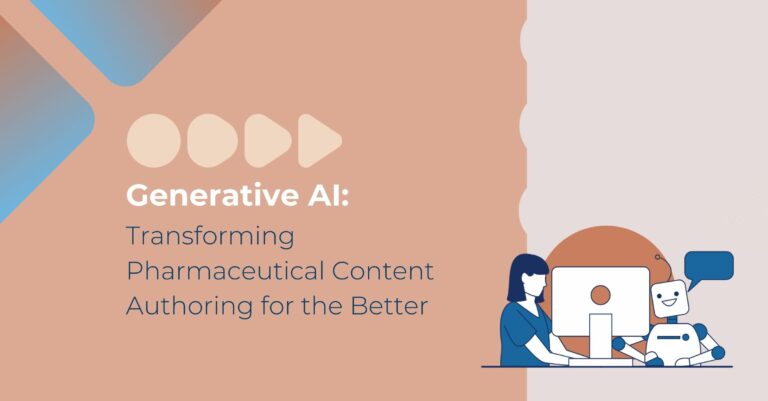
Generative AI, a subset of artificial intelligence that analyzes large volumes of data to create text, images, and other outputs, is quickly becoming a disruptive force in the life sciences industry. For example, this purpose-built technology is employed to accelerate drug discovery, improve clinical trial planning and execution, decrease drug recalls, and lead to more precision medicine therapies. [1]
Not only can Generative AI help life sciences companies unlock value in new ways, it can also change the way these organizations approach existing processes and address specific challenges. Below, we conduct a deep dive into three pharmaceutical content authoring use cases highlighting how Generative AI can be leveraged to improve existing processes, ensure sustained quality and compliance, reduce costs, and improve patient safety.
What is Generative AI?
Technically speaking, Generative AI is capable of producing text, images, media (i.e., video, music), and other outputs using generative models. These models are trained on industry-specific data sets, learn the patterns and structure of their input training data, and then create new data and outputs with similar characteristics. Most commonly, generative AI models generate content in response to natural language requests (i.e., the model does not require code), although use cases can vary.
At their core, trained generative AI models are essentially prediction algorithms, though the complex math and enormous computing power required to create them make them much more sophisticated and powerful.
Taking a Deeper Look into LLMs
According to Arria, a Gartner-designated leader in natural language technology and Generative AI, natural language generation (NLG) platforms can be used to generate language deterministically. These technologies automate reports directly from data in highly regulated, compliant, and mission-critical use cases where 100% accuracy and consistency are required.
This includes cases requiring pure process automation without human intervention. Available LLMs, including ChatGPT and others, can be used effectively to generate content from unstructured text across many use cases and can be augmented by human editing to ensure accuracy. Combining advanced prompt engineering techniques and/or fine-tuning of LLMs can increase the effectiveness of LLMs, but they still require human augmentation. Arria is in advanced development of an approach to combine the synergies and benefits of both deterministic and LLM models to address broader use case sets reliably to reduce hallucinations and reduce the levels of human augmentation required.
Generative AI in Life Sciences
“Though there’s no doubt Generative AI will revolutionize content creation workflows, what about organizations in high-trust sectors – like life sciences – who want to leverage proprietary data with enterprise-level accuracy? That’s what we’re focused on.” – Arria Spokesperson
Traditionally, there have been many hurdles to AI adoption across the life sciences industry, ranging from model “explainability” (i.e., how the algorithms work) to concerns about inherent bias to the lack of regulations governing the use of the technology. [2] However, because Generative AI requires less data, it is more adaptable to unfamiliar situations, and can interface better with clinical staff than other AI models, it is much better positioned to become widely adopted. [3]
As Arria’s Sharon Daniels notes, “[we have] decades of experience in the life sciences space, and our unified architecture brings together the benefits of Arria Studio (Arria’s generative AI platform) and LLMs (large language models) into a single framework that maximizes the synergies while mitigating the inherent predictability risks of an LLM in a mission-critical use case.”
Generative AI models have already been proven to be broadly applicable and transferable to different life sciences processes and tasks – emerging use cases now exist across industry players, from providers and pharmaceutical firms to payers, MedTech, service providers, and public health agencies. For example, pharmaceutical companies like Insilico Medicine are leveraging Generative AI to reduce costs and speed up drug discovery. In Insilico Medicine’s case, the company brought its idiopathic pulmonary fibrosis drug from novel-target discovery to a preclinical candidate in just 18 months, spending only $2.6 million.
The drug recently received the agency’s Orphan Drug Designation after completing the preclinical phase in 30 months, much faster than average for a new treatment. Further, according to prominent technology research firm Gartner, by analyzing large volumes of medical data, Generative AI algorithms can create content that directly improves the quality of patient care, makes medical procedures more accessible and affordable, reduce inequities in research and care delivery, and helps companies ensure sustained quality and compliance, reduce costs, and improve time to market.
Use Cases for Generative AI in Pharmaceutical Content Authoring
While Generative AI clearly has many life sciences applications, pharmaceutical content authoring is one of the areas most ripe for disruption. Today, pharmaceutical content authoring (i.e., report writing, form development, labeling, etc.) is time-intensive, manual, and prone to human error. Generative AI can augment content authors’ ability to draft and edit text, images, and other media to create compliant, submission-ready documents. It can also summarize, simplify, translate, and classify content to quickly create a wide range of artifacts at scale, all while keeping a human in the loop to perform reviews and quality checks.
Use Case 1: Report Writing
Pharmaceutical companies develop hundreds of reports annually, ranging from clinical studies to pharmacovigilance reports. The critical challenge around all report writing is quickly and easily assembling reasonable narratives based on charts, graphs, and other visual data. Today, content authors not only need to manually interpret data (i.e., from clinical studies) to develop the textual analysis that will make up most of the report, but they also need to physically re-create any associated charts and graphs in a readable, easily digestible format.
Pharmaceutical content authoring teams can augment the report-writing process by leveraging Generative AI models to create outlines and extract key content to serve as the basis of the report. This is done using a life sciences-trained natural language process tool to crawl the organization’s systems for structured and unstructured data and then feed that data to the generative AI model.
Alternatively, content authors can go a step further and use Generative AI models to fully synthesize related data and produce a complete draft output of text in the desired style and length for review. At the end of the process, Generative AI can even be used to manipulate the report’s tone (i.e., professionalize).
Regarding report writing, Generative AI models can provide a distinct advantage to life sciences companies. For example, Arria found that after deploying generative AI models in conjunction with existing natural language technologies, life sciences companies report an 80% reduction in manual report generation labor, 30-60% time savings for Business Intelligence analysts, elimination of human error in report writing, and an increase in annual revenue of up to 2%. Further, leveraging Generative AI frees up content authors to pursue other value-add activities and even fuel innovation since they will no longer need to spend cycles developing reports from scratch.
Use Case 2: Informed Consent Forms
When conducting clinical trials, pharmaceutical companies need to be able to generate specific forms based on how a patient answers a particular question (i.e., are you pregnant? Y/N) so that the patient is fully aware of what is being consented to. In this case, Generative AI can be employed to do two things: (1) generate the correct document based on upstream information and pre-set conditional rules (2) translate scientific language into “plain English” using a pre-determined phrase library.
Use Case 3: Intelligent Sentence Generator for Pharmaceutical Labeling
Drug labels have notoriously been criticized for being overly complex and difficult to read and pharmaceutical companies have struggled to generate recommended regulatory language at the right reading comprehension level. To address this issue, pharmaceutical companies can harness the power of Generative AI to transform existing label language into sentences and sections that are simple, clear, concise, and familiar.
First, pharmaceutical companies can feed their Generative AI models information about the reading comprehension level (i.e., 8th grade level [4]) at which it should be generating label content.
Second, these Generative AI models can be deployed behind a client firewall to leverage client-only label content and approved phrase libraries to generate appropriate sentences.
These outputs then provide guidelines for improvement and standardization, which are then reviewed and approved by a “human in the loop” who understands culture, context, and compliance and can ensure labels meet current evolving cultural and health authority requirements in each of the local label geographies. Broadly speaking, this enables content authors to develop label language that is familiar to patients in the given geography, increasing compliance and patient safety.
The Future of Generative AI
The field of generative AI will continue to progress rapidly in both scientific discovery and technology commercialization. For example, by 2025, Gartner predicts that more than 30% of new drugs and materials will be systematically discovered using generative AI techniques, up from nearly zero today.
“Generative AI represents a monumental leap forward, enabling technology to evolve rapidly,” writes Arria Chief Technical Officer Neil Burnett. “Life sciences are poised to realize tremendous value by applying solutions like Arria’s GenAI, which enhances their existing natural language generation capabilities. With thoughtful implementation that prioritizes safety, accuracy, and reliability from the outset, Generative AI can provide pharmaceutical experts with previously unimaginable insights from complex data. This facilitates accelerated drug discovery and development, improved clinical trial recruitment and reporting, and instant answers to complex regulatory questions. It is critical to build flexible frameworks integrating new developments as this technology continues its breakneck advancement. With the right strategy anchored by core principles, Generative AI can usher in an era of boundless innovation across the life sciences industry and beyond.”
[1] How Generative AI is Transforming Healthcare Sooner Than Expected
[2] Obstacles to Widespread Adoption of AI in the Healthcare Industry
[3] Gartner
[4] The average American reads at the 7th- to 8th-grade level per data collected by the Organization for Economic Cooperation and Development


